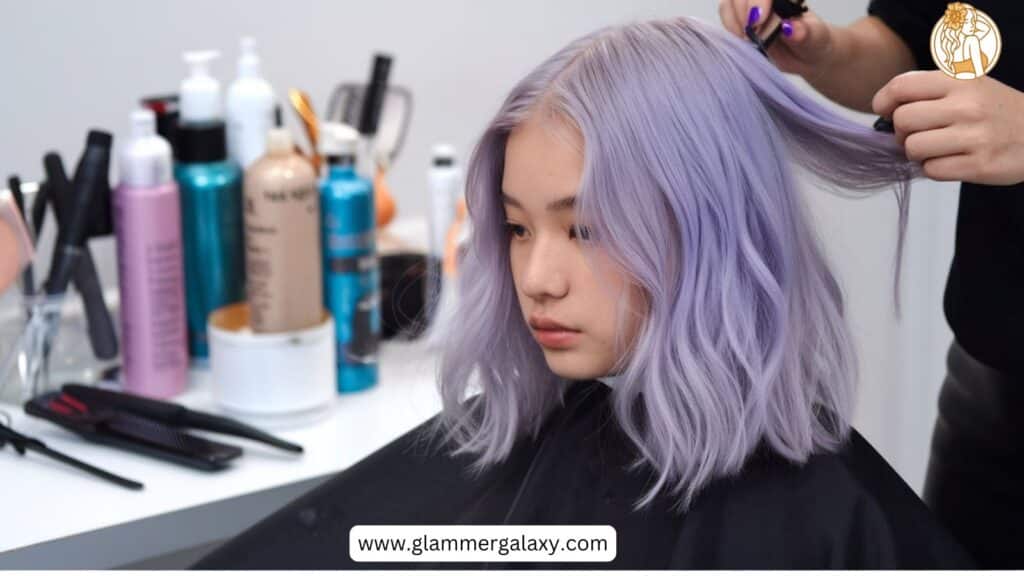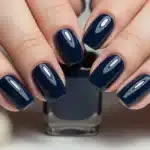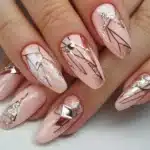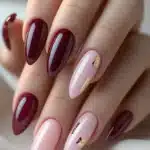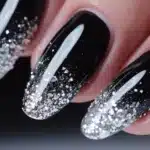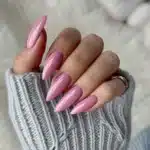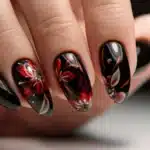If you’ve been rocking vivid purple hair and now dream of an icy hue, you’re in the right place to learn Fade Purple Hair to Silver
This comprehensive guide will walk you through the process of fading purple hair to silver, offering expert tips and tricks along the way.
Understanding Hair Color Chemistry

Before we jump into the nitty-gritty of fading your purple locks, let’s take a moment to grasp the science behind hair color. This knowledge will help you understand the process better and achieve the best results.
The Pigment Puzzle
Hair color is determined by two types of melanin:
- Eumelanin: Responsible for brown and black pigments
- Pheomelanin: Creates red and yellow hues
When you dye your hair purple, you’re adding artificial pigments that sit on top of your natural color. The hair color chemistry behind purple hair tones is a mix of red and blue pigments. As these pigments fade, they leave behind different shades, which is why your bright violet hair might go through various stages before reaching silver.
The Fading Process
Hair dye fading is a natural process that occurs due to several factors:
- Washing frequency
- Water temperature
- UV exposure
- Use of harsh shampoos
- Heat styling
Understanding these factors will help you manage the fading process more effectively as you transition to silver.
The Role of Hair Structure
Your hair’s structure plays a crucial role in how it holds and releases color:
- Cuticle: The outer layer of the hair shaft, made up of overlapping scales
- Cortex: The middle layer, where most of the hair’s pigment is found
- Medulla: The innermost layer, which may be absent in fine hair
The condition of your cuticle significantly affects how well your hair retains color. Damaged or raised cuticles can lead to faster color loss.
Pre-Fading Considerations
Before you start your journey from vibrant purple locks to icy silver locks, there are a few things to consider:
Assessing Your Hair’s Health
Healthy hair is crucial for a successful color transition. Here’s a quick checklist:
- No significant breakage or split ends
- Moisturized and not overly dry
- No recent chemical treatments (perms, relaxers)
- Minimal heat damage
If your hair doesn’t meet these criteria, consider focusing on hair health for a few weeks before starting the fading process. This might involve:
- Deep conditioning treatments
- Protein treatments for strengthening
- Trimming split ends
- Reducing heat styling
Evaluating Your Current Purple Shade
The intensity of your current purple will affect the fading process. Consider the following:
| Purple Shade | Ease of Fading | Expected Time |
| Pastel | Easier | 2-4 weeks |
| Medium | Moderate | 4-6 weeks |
| Deep/Vivid | Challenging | 6-8 weeks |
Setting Realistic Expectations
Remember, the journey from purple to silver isn’t always a straight path. Your hair might go through various stages, including:
- Faded lavender
- Pale pink
- Light blue
- Ash blonde
Be patient and embrace each stage of the process!
Consulting a Professional
While it’s possible to fade purple hair to silver at home, consulting a professional colorist can provide valuable insights:
- They can assess your hair’s condition in person
- Offer personalized advice based on your hair type and history
- Recommend professional-grade products
- Provide a realistic timeline for your color transformation
Essential Tools and Products
To successfully fade your purple hair to silver, you’ll need the right arsenal. Here’s what you should gather:
- Clarifying shampoo
- Hair lightener or bleach
- Toner
- Silver hair color
- Deep conditioning treatments
- Heat protectant
- Gloves and mixing bowls
- Applicator brush
- Plastic shower cap
- Old towels (to protect clothing)
Pro tip: Invest in quality products to minimize damage and achieve the best results. Here’s a breakdown of why each item is essential:
- Clarifying shampoo: Removes product buildup and prepares hair for color change
- Hair lightener or bleach: Lifts existing color to create a blank canvas for silver
- Toner: Neutralizes unwanted warm tones after lightening
- Silver hair color: Deposits the final silver shade
- Deep conditioning treatments: Restores moisture and strengthens hair
- Heat protectant: Shields hair from heat damage during styling
- Gloves and mixing bowls: For safe and clean application of products
- Applicator brush: Ensures even distribution of color
- Plastic shower cap: Keeps hair moist during processing
- Old towels: Protects clothing and surfaces from stains
The Step-by-Step Fading Process
Now, let’s explore the heart of our guide – the step-by-step process to fade purple hair to silver.
Step # 1 Preparing Your Hair
- Start with a clarifying wash to remove any product buildup. This step is crucial as it ensures that the lightener can penetrate the hair shaft effectively.
- Perform a strand test to see how your hair reacts to the lightening process. This involves:
- Selecting a small, inconspicuous section of hair
- Applying the lightener as you would to your whole head
- Monitoring the color change and checking for any adverse reactions
Step # 2 : Lightening your hair (If Necessary)
If your purple is still vivid, you might need to lighten your hair first. This step is often necessary to create a blank canvas for your silver color.
- Mix the lightener according to the instructions. Be precise with measurements to ensure optimal results.
- Apply to dry hair, starting from the back and working your way forward. This technique helps because:
- The back of your head processes slower due to less body heat
- It’s easier to ensure even application when you can see what you’re doing
- Monitor the process closely – don’t leave it on for longer than recommended. Check your hair every 5-10 minutes to avoid over-processing.
- Rinse thoroughly with cool water and assess the results. Cool water helps to close the cuticle and lock in the color.
“Patience is key when bleaching the hair. It’s better to go slow and steady than to rush and damage your locks.” – Professional Colorist Jane Doe
Step # 3 : Toning the hair
Toning the hair is crucial for neutralizing any unwanted warm tones. This step is what transforms your hair from potentially brassy to a cool, silvery shade.
- Choose a toner that matches your desired silver shade. Options might include:
- Ash blonde toner for a warmer silver
- Blue-based toner for a cooler, more metallic silver
- Apply evenly to damp hair. Damp hair allows for more even distribution of the toner.
- Process according to the instructions, usually 10-20 minutes. Keep a close eye on the color development to avoid over-toning.
- Rinse with cool water to seal the cuticle and lock in the tone.
Step # 4 : Selecting the right dye
Now comes the exciting part – achieving that shimmering silver you’ve been dreaming of!
- Mix your silver hair dye according to the instructions. Be sure to wear gloves to protect your skin from staining.
- Section your hair for even application. Divide your hair into four quadrants:
- Part your hair down the middle from forehead to nape
- Create a horizontal part from ear to ear
- Apply the dye from roots to tips, ensuring full coverage. Start with the back sections and work your way forward.
- Process for the recommended time. This usually ranges from 30 minutes to an hour, depending on the brand and desired intensity.
- Rinse with cool water until it runs clear. This might take several minutes, so be patient to ensure all excess dye is removed.
Step 5: Hair Bleaching

Have you not pre-lightened your hair yet? Don’t worry! You need to bleach it first before using that silver shade of hair dye. Otherwise you will end with a dirty looking mess. Below is how you can professionally lighten your hair:
1- Part your hair into four sections and hold them up. Mix the 30 vol developer with your lightener and then move quickly! Apply this mixture evenly from the roots to ends. Keep an eye on it for about 25-30 minutes without letting go of sight.
2-Finally rinse off using warm water until all the washout is completely clear which is after conditioning strands in air-dried method for some time
Step 6: Dry and Style

Now we are finally at the last step. it’s time to go in style with your killer new silver-purple hair dye:
Forget about towel drying, opt for air drying or using the blow dryer only. You need to avoid damaging your strands. Feel free to add some waves or straightening it up but do not over do it because it can damage your hair.
To boost the shine, use a protective serum or oil. This makes your metallic mane look more sumptuous. Now walk around flaunting this cool new look! You have put on a completely different hair era.
See also : Can I Use Eyeliner On My Lips?
Maintaining Your Silver Locks
Maintaining the silver color requires some effort, but it’s worth it for that stunning metallic hair shade. Here are some detailed tips:
Weekly Maintenance
- Use purple shampoo once a week to combat brassiness. Leave it on for 3-5 minutes before rinsing.
- Incorporate color-depositing conditioners into your routine. These help to refresh the silver tone between full color treatments.
Styling Considerations
- Limit heat styling and always use a heat protectant. High temperatures can cause the silver color to fade more quickly.
- When using heat tools, opt for lower temperature settings. Aim for 300-350°F (150-175°C) instead of maximum heat.
Environmental Protection
- Protect your hair from the sun with hats or UV-protective products. UV rays can cause color to fade and become brassy.
- If you’re a swimmer, wet your hair with clean water and apply a leave-in conditioner before entering chlorinated pools. This creates a barrier that helps prevent the chlorine from altering your color.
Touch-Up Techniques
- Schedule regular touch-ups to keep your silver looking fresh. This is typically needed every 4-6 weeks.
- Consider root touch-up products for quick fixes between salon visits. These come in various forms like sprays, powders, or temporary color sticks.
Nutrition for Hair Health
Remember, healthy hair holds color better. Consider incorporating these nutrients into your diet:
- Biotin: Found in eggs, nuts, and whole grains
- Omega-3 fatty acids: Found in fish, flaxseeds, and walnuts
- Vitamin C: Found in citrus fruits, berries, and leafy greens
Troubleshooting Common Issues
Even with the best care, you might encounter some challenges. Here’s how to address them:
Dealing with Brassiness
If your silver starts to look yellow or brassy, use a purple toner or blue shampoo to neutralize the warm tones. Here’s a quick guide:
- For slight brassiness: Use purple shampoo 1-2 times a week
- For moderate brassiness: Apply a purple toning mask for 10-15 minutes
- For severe brassiness: Consider a professional toning treatment
Addressing Uneven Fading
Sometimes, color loss can be patchy. In this case, consider:
- Using a color-removing product to even out the tone. Apply only to the darker areas to create a more uniform base.
- Applying a semi-permanent silver dye to blend the colors. This can help create a more cohesive look without the commitment of permanent dye.
Managing Dryness and Damage
Silver hair can be prone to dryness. Combat this with:
- Weekly deep conditioning treatments. Look for products rich in proteins and moisturizing oils.
- Leave-in conditioners to provide continuous hydration throughout the day.
- Regular trims to remove split ends, ideally every 6-8 weeks.
- Silk or satin pillowcases to reduce friction and moisture loss while you sleep.
Combating Fading
To keep your silver vibrant for longer:
- Wash your hair less frequently, ideally 2-3 times a week.
- Use dry shampoo between washes to keep your hair fresh.
- Rinse with cool water to help seal the cuticle and lock in color.
- Avoid clarifying shampoos after coloring, as they can strip the dye more quickly.
Expert Tips and Tricks
To take your silver hair game to the next level, consider these professional insights:
- Use temporary silver sprays for a quick touch-up between dye jobs. These can be particularly useful for covering regrowth or refreshing dull areas.
- Blend with your natural growth by using a root smudging technique. This involves applying a darker shade at the roots and blending it into the silver for a more natural transition.
- Experiment with silver-purple combo looks for a unique twist. Try:
- Silver with lavender highlights
- Ombre effect from deep purple to silver
- Silver base with purple peek-a-boo strands
- Try silver-grey hue variations like steel blue or lavender silver for added dimension. These subtle variations can add depth and interest to your look.
- Use a color-depositing hair mask once a week to maintain the intensity of your silver. This can help extend the time between full color treatments.
- Incorporate glossing treatments into your hair care routine. These can add shine and help seal the cuticle, prolonging your color’s vibrancy.
- Consider a shadow root technique where your natural or darker color is left at the roots. This can create a more low-maintenance look and add depth to your silver style.
Explore similar content:
Hair Tinsel on Curly Hair: The Ultimate Glamour Guide
Case Study: Sarah’s Purple to Silver Transformation
Sarah, a 28-year-old graphic designer, decided to transition her vivid purple hair to silver. Here’s how her journey unfolded:
Week 1-2: Sarah began by using a clarifying shampoo twice a week to gently fade her purple. She noticed her hair becoming a softer lavender shade.
Week 3-4: With her purple significantly faded, Sarah visited a salon for professional lightening. The stylist used a low-volume developer to minimize damage.
Week 5: After a week of deep conditioning treatments, Sarah’s hair was toned to neutralize remaining warm tones.
Week 6: The silver dye was applied, resulting in a stunning metallic shade.
Maintenance: Sarah now uses purple shampoo once a week and a color-depositing conditioner to maintain her silver. She gets touch-ups every 6 weeks.
Sarah’s stylist notes: “The key to Sarah’s successful transition was patience and proper hair care between each step. This allowed us to achieve the silver she wanted while keeping her hair healthy.”
The Psychology of Silver Hair
Embracing silver hair isn’t just about aesthetics – it can be a powerful statement. Many find that going silver boosts their confidence and challenges conventional beauty standards. It’s a bold choice that says, “I’m comfortable in my own skin.”
“Silver hair isn’t about age – it’s about attitude. It’s a color that demands attention and exudes confidence.” – Fashion Stylist Mark Smith
The Impact of Silver Hair
- Perception of Confidence: Many report feeling more self-assured with silver hair, as it’s often associated with wisdom and uniqueness.
- Breaking Age Stereotypes: Young people with silver hair challenge the notion that it’s exclusively for older individuals.
- Fashion Versatility: Silver hair can complement a wide range of fashion styles, from edgy to elegant.
- Self-Expression: Choosing silver hair can be a form of artistic expression, allowing individuals to showcase their personality.
FAQs
Q: How long does the fading process from purple to silver typically take?
A: The process can take anywhere from 2-8 weeks, depending on the intensity of your purple and how often you wash your hair. Darker purples may take longer to fade completely.
Q: Can I fade purple to silver at home safely?
A: Yes, but it requires patience and careful attention to instructions. For best results, consider consulting a professional colorist, especially for the lightening process if needed.
Q: Will silver hair suit my skin tone?
A: Silver can complement many skin tones. Cooler silvers often suit cool skin tones, while warmer silvers can flatter warm skin tones. A professional colorist can help you choose the most flattering shade.
You might like:
14 Amazing Nails Colors Guide for Burgundy Dress
Conclusion
Transitioning from vivid purple hair to a stunning silver is an exciting journey that requires patience, care, and the right techniques. By following this comprehensive guide, you’re well-equipped to achieve the icy silver locks of your dreams. Remember, the key to success lies in understanding the science behind hair color, properly preparing your hair, and maintaining the silver color once you’ve achieved it.
Whether you’re looking for a dramatic change or simply want to try something new, fading your purple hair to silver can be a fun and rewarding experience. Embrace each stage of the process, and don’t be afraid to experiment with different silver and purple hair dye combinations along the way.
As you embark on this color transformation, keep these key points in mind:
- Hair Health is Paramount: Prioritize the condition of your hair throughout the process. Regular deep conditioning and minimal heat styling will help maintain your hair’s integrity.
- Patience Pays Off: The journey from purple to silver isn’t instant. Embrace the in-between stages and view them as part of your unique style evolution.
- Professional Help Can Be Invaluable: While DIY methods can work, consulting with a professional colorist, especially for the lightening process, can help you achieve optimal results with minimal damage.
- Maintenance is Key: Once you’ve achieved your desired silver shade, consistent care will keep it looking fresh and vibrant. Invest in color-safe products and stick to a regular touch-up schedule.
- Embrace the Versatility: Silver hair offers a unique canvas for self-expression. Don’t be afraid to play with different tones and styles to find what best suits your personality and lifestyle.
- Stay Informed: Hair color trends and techniques are always evolving. Keep yourself updated on new products and methods that could enhance your silver hair journey.

Sarah Williams is an experienced blogger and fashion enthusiast at Glammer Galaxy. With a passion for beauty and style, she shares expert insights on hair trends, nail art, and fashion tips. Her creative flair and years of experience make her a go-to source for all things glam!

